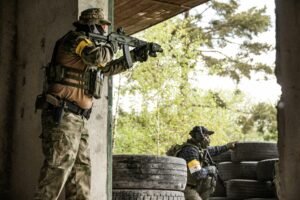
In a dramatic escalation, Ukrainian forces crossed the border into Russia in early August 2024, advancing up to 30 kilometers into the Kursk region. This surprise move resulted in the evacuation of nearly 200,000 people from border areas, with Russian President Vladimir Putin condemning the attack as a “major provocation.” After two weeks of intense fighting, Ukraine’s top commander announced control of over 1,200 square kilometers of Russian territory, including 93 villages. Both Kursk and Belgorod regions declared states of emergency in response to the offensive.
Ukraine’s bold counter-offensive seems designed to force Russia into redeploying troops from the heavily contested eastern front, where Ukrainian defenses have faced relentless pressure. Additionally, Kyiv aims to improve its leverage in potential peace talks by shifting the dynamics of the conflict.
Russian Incursion Near Kharkiv
In early May 2024, Russian forces launched an incursion north of Ukraine’s second-largest city, Kharkiv, seizing several villages and prompting thousands of civilians to flee. This marked one of the most significant ground assaults by Russian troops since the early days of the war. The attack came during a four-month period when the U.S. halted weapons supplies to Ukraine due to a political stalemate in Congress. However, by late April, the U.S. approved a $61 billion aid package, providing Ukraine with much-needed missiles, artillery, and air-defense systems.
Despite repeated Russian air strikes on Kharkiv, Ukrainian forces successfully held their ground, preventing the city from falling within Russian artillery range. The defense of Kharkiv has been a symbolic and strategic victory for Ukraine in its ongoing efforts to repel Russian advances.

Russian Advances in Eastern Ukraine
The fighting around Kharkiv, while significant, is far removed from the main front line in eastern Ukraine, where Russian forces have been gradually advancing since October 2023. This region, particularly the Donetsk and Luhansk areas, has been the epicenter of conflict since 2014 when Russian-backed forces seized large portions of the territory.
Russia’s main advantage in the east is its vast manpower, which it has used to slowly grind down Ukrainian defenses. Western officials reported that around 1,200 Russian soldiers were killed or wounded daily during May and June, marking the highest casualty rate since the war began. In recent weeks, Russian forces made gains north-west of Donetsk, capturing the small town of Niu-York. In response, Ukraine ordered the evacuation of Pokrovsk, with local military officials warning that Russian forces were rapidly closing in on the city.
The advance toward Pokrovsk marks the most significant change in the eastern front line in months. The last major shift occurred when Ukrainian forces withdrew from Avdiivka in February 2024, after months of grueling combat. The town, once home to more than 30,000 residents, has been almost entirely destroyed by the conflict.
Continued Fighting Around Bakhmut
To the north of Donetsk, the area around Bakhmut has remained one of the war’s most intense battlegrounds. Both Russian and Ukrainian forces have sustained heavy losses as they vie for control of this strategic area. Although Ukraine gained some ground around Chasiv Yar, situated 10 kilometers west of Bakhmut, Russian forces have since regained some of their lost positions. The battle for Bakhmut continues to drain resources and manpower from both sides, with no decisive outcome in sight.
A War of Attrition: Two and a Half Years of Conflict
The conflict between Russia and Ukraine began on February 24, 2022, with a series of missile strikes on major Ukrainian cities, followed by a large-scale ground invasion. In the early weeks of the war, Russian troops captured significant territory in the south and east of Ukraine and even reached the suburbs of the capital, Kyiv.
However, Russia’s advance soon stalled due to fierce Ukrainian resistance and logistical challenges faced by Russian forces. With Western military aid flowing into Ukraine, including highly effective anti-tank weapons like the NLAW, Ukrainian forces were able to push back. By October 2022, Russia withdrew its forces from northern Ukraine, including the Kyiv region. In November of that year, Ukrainian forces recaptured the southern city of Kherson, marking a pivotal moment in the conflict.
Since then, the war has largely shifted to eastern Ukraine, where Russia has slowly advanced at great cost. Estimates suggest that Russia has lost at least 50,000 soldiers since the conflict began, though the true number could be much higher.
Conclusion: An Ongoing Struggle
As the conflict nears the two-and-a-half-year mark, both sides continue to suffer heavy casualties, with no clear end in sight. Russia’s grinding advance in the east and Ukraine’s recent counter-offensive in Russia suggest that both nations are still determined to achieve military victories. However, the war’s toll on civilians and infrastructure continues to grow, and the prospect of a negotiated peace remains distant. With international support for Ukraine showing no signs of wavering, the war is likely to drag on, further reshaping the political and military landscape of Eastern Europe.








